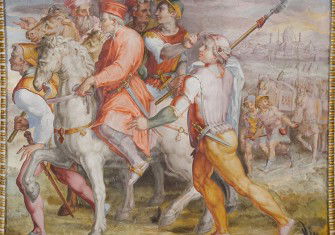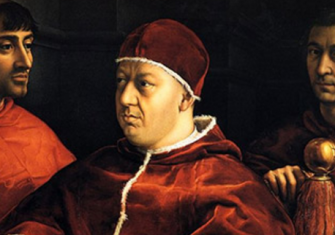Murder at the Vatican
An unsolved Renaissance mystery casts light on the dark world of extortion, revenge and power politics at the heart of the Catholic Church. Was there any truth to the plot to kill Pope Leo X?
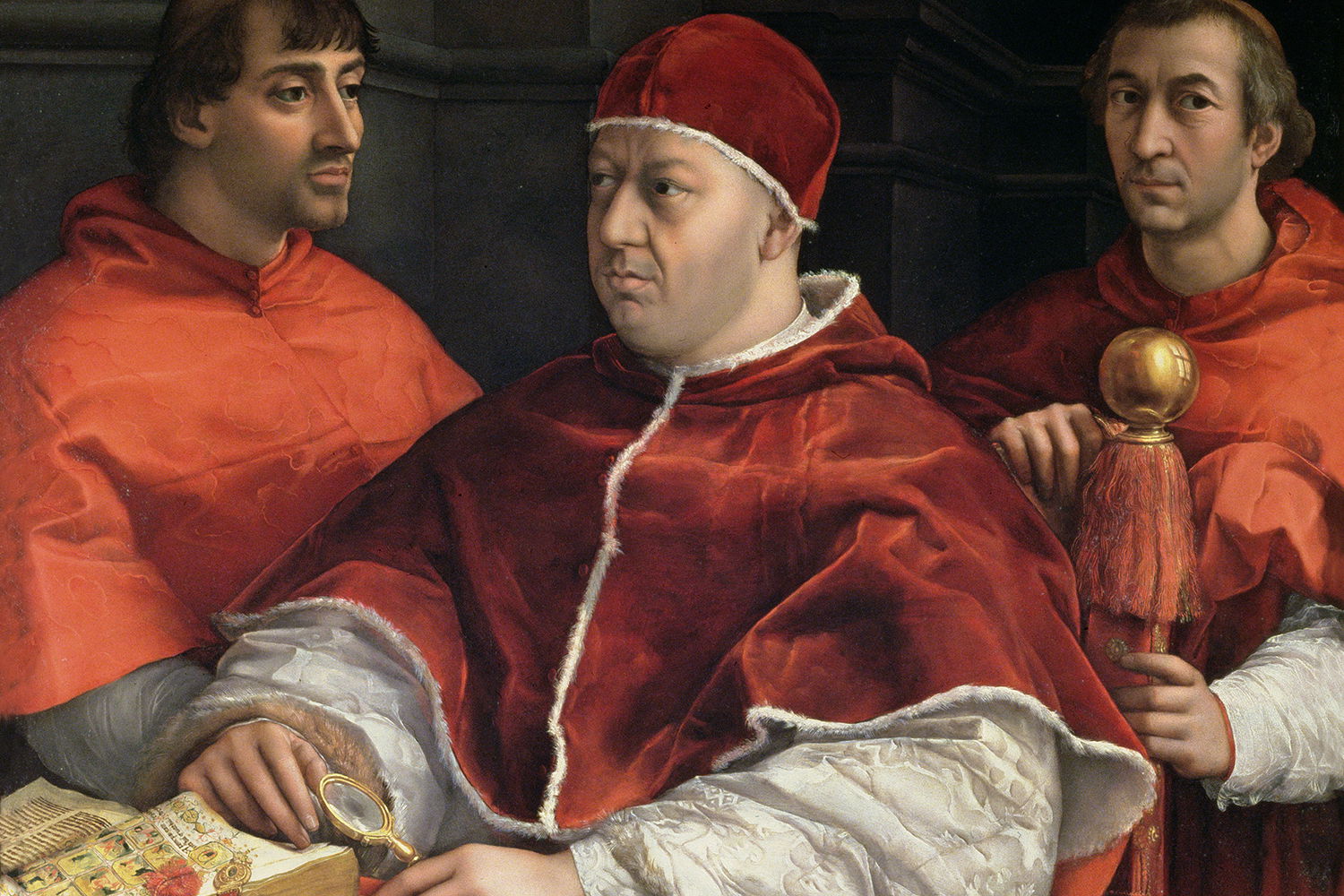
Cardinal Alfonso Petrucci was strangled in his cell in the Castel Sant’Angelo, Rome on 4 July 1517. He was 26. He had been a prisoner in the papal fortress for six weeks, one of five cardinals accused of plotting to poison Pope Leo X. His execution was judicially sanctioned, but in the most dubious of circumstances. Right from the start, observers asked whether there was really a plot, or whether Petrucci and his colleagues were framed by Leo in his pursuit of power, wealth and the interests of his family, the Medici. The ‘abominable case’ of the Cardinals’ Conspiracy is one of the great Renaissance mysteries.
The affair had begun on 15 April that year, when four of Petrucci’s associates were arrested. They included Marcantonio Nini (his major-domo), his business agent, a groom and his cousin Scipione Petrucci. Two judges were appointed to conduct the investigation. The first, Giangiacomo di Gambarana, who was on the legal staff of the governor of Rome, was nothing out of the ordinary. The appointment of a second, not required by law, was unusual. Domenico Coletta was vice-castellan of the Castel Sant’Angelo (the papal fortress on the banks of the Tiber). But he was also an associate of a branch of the Petrucci family deeply hostile to Cardinal Alfonso. The prosecutor was Mario Peruschi. His reputation preceded him. At least two suspects in Peruschi’s previous cases had died in custody.
The choice to interrogate the servants first was probably not accidental. They were unlikely to have powerful friends to intervene on their behalf and could more easily be threatened with torture. Nini was a boyfriend of Giulio de’ Bianchi, a papal chamberlain, who died in mysterious circumstances, possibly poisoned, before the trial began. It may have been Bianchi who revealed the details of the plot – truthfully or otherwise – to the pope.
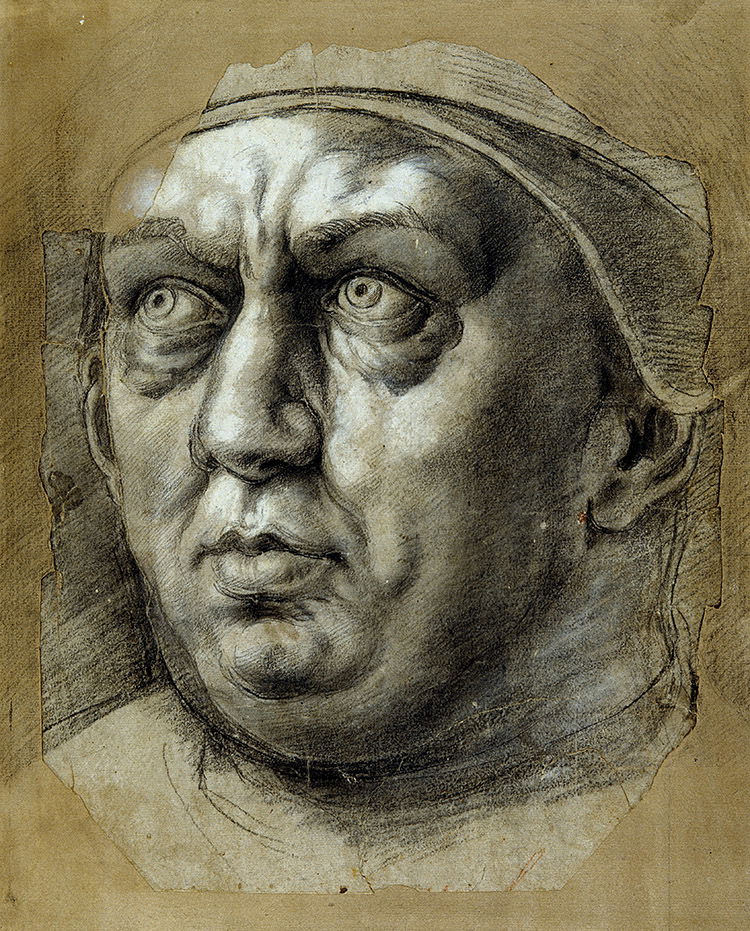
When the questioning began, on 17 April, it focused not on poison but on Petrucci’s political manoeuvring. Cardinal Petrucci came from the Tuscan city of Siena, a rival of the pope’s home city of Florence (16th-century Italy was divided into numerous small states). The previous year, Leo had ousted Petrucci’s relative from the rulership of Siena and brought it under the ‘protection’ of the papacy. Angry, Petrucci spent months negotiating an alliance to retake the city, behaviour that Leo regarded as lèse majesté.
Defying the pope over Siena was one thing. Murder was quite another. For the first ten days of Nini’s interrogation no allegation of a poison plot was made. That all changed on 27 April, when Peruschi presented him with 18 letters, seven signed by Nini himself and addressed to Cardinal Petrucci, most of them from August 1516. Nini was asked to confirm that they were in his hand. In one letter, the words ‘I spoke with Vercelli’ appeared. Battista Vercelli was a doctor. In the summer of 1516, when Leo had been seriously ill, there had been discussion about his treating the pope, with Leo’s usual physician away. As a doctor, he had the means to administer poison; if he got the position he would have the opportunity; and Petrucci had the motive. The prosecutor had the makings of a case. All he needed was a confession.
Whose conspiracy?
The standard method of torture in this period consisted of tying the suspect’s hands behind his back, then suspending him by his wrists. It caused excruciating pain (four centuries later the SS used it in concentration camps). Nini soon spilled details of an elaborate plot to his interrogators, implicating five named cardinals – Petrucci, Bendinello Sauli, Raffaelle Riario, Adriano Castellesi and Francesco Soderini – plus two others who were never identified.
Was any of what Nini said true? Or was he simply telling his interrogators what they wanted to hear? Historians have long debated whether there was a Cardinals’ Conspiracy at all. The historical sources for the events of 1517 are numerous and contradictory. The obvious starting point would be the cardinals’ own testimony, but it is lost. (It is tempting to put a conspiratorial spin on that, but there are numerous lacunae in the papal papers of this period due to the Sack of Rome in 1527 and the subsequent exile of the pope.) There is, however, a draft of Nini’s interrogation and that of Petrucci’s other associates. None of the compromising letters survive, but one letter from Nini – not included in the trial – does and, importantly, it was annotated by the interrogators in a way that suggests they were seeking to place the worst possible spin on his words.
Then there are accounts by others: the papal master-of-ceremonies, Paride Grassi; a Portuguese servant of Petrucci; an elderly resident of the papal palace whose apartments overlooked the route to the Castel Sant’Angelo; and ambassadors in Rome. The consistory records tell us what was said in the formal meetings of the cardinals. A 16th-century document apparently written by supporters of the accused gives details of the affair from their point of view, although in dates and other specifics it has some discrepancies with the interrogation records. Cardinal Sauli’s account books give some intriguing financial information.
It is not surprising that the facts of the affair are elusive, but a look at the background shows why Leo X might have been tempted to take advantage of even the slenderest evidence of a plot.
Leo had been elected a little more than four years earlier. Giovanni de’ Medici – to give him his birth name – was the second son of Lorenzo ‘the Magnificent’, ruler of Florence, and had been elevated to the cardinalate at the age of 13. Although Giovanni was an unusually precocious candidate, Lorenzo was typical of Italian rulers in seeking a red hat for his son. The papacy was a powerful force on the Italian peninsula, ruling a chunk of Italy that stretched north from Rome to Bologna and east to the Adriatic coast and the city of Ravenna. Even where they did not rule directly, their appointees – bishops and abbots – exercised control over substantial lands. Representation in the curia was essential for a family serious about its influence. The Gonzaga lords of Mantua got their first cardinal in 1461; the Sforza rulers of Milan joined them in 1484.
The Medici Pope
The role of these family cardinals was an ambiguous one. Lorenzo wrote a letter to his son advising him how to manage his new responsibilities. Although young Giovanni ‘ought to aim at being a good ecclesiastic, and to show that you prefer the honor and state of the church and of the apostolic see to every other consideration’, he was also to be ‘the link to bind this city closer to the church and our family with the city’. Lorenzo’s plan was wise. In 1494 the Medici had been expelled from Florence, as French troops marched down the Italian peninsula in a quest to assert an old claim to Naples. Rome and the papal court became the family’s only base and it fell to Cardinal Giovanni to sustain its grip on power. From 1503, when Giovanni’s elder brother Piero, nicknamed ‘the Unfortunate’, died, Giovanni’s role became all the more important.
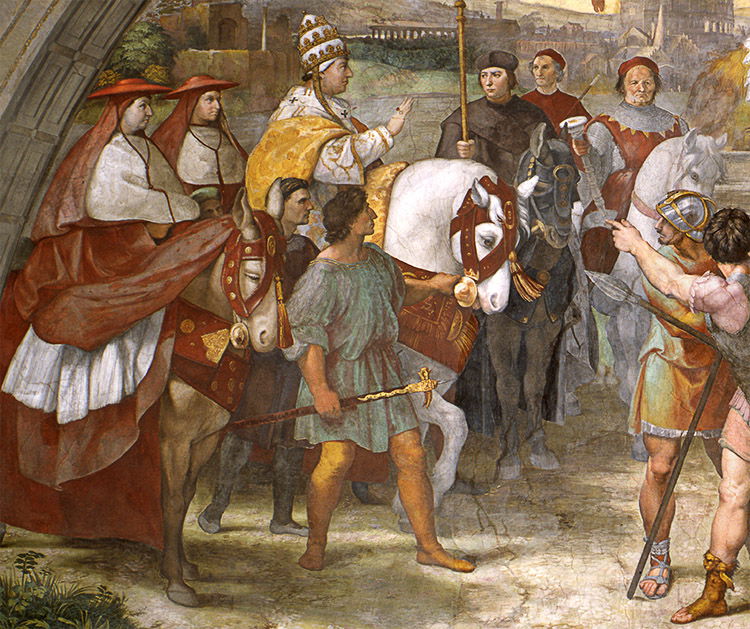
Cardinal Giovanni de’ Medici made a military alliance with Spain in 1512 to secure his family’s return to Florence. His younger brother Giuliano, Duke of Nemours, became the city’s de facto ruler. The following year, Pope Julius II died. Cardinal Giovanni made a slow and painful journey to the conclave. He was suffering from an anal fistula and a surgeon had to be on hand to attend him throughout. Despite (or perhaps because of) his illness, which promised a relatively short papacy, Giovanni de’ Medici was one of the two leading candidates for election as pope. The other was Raffaele Riario, a relative of the late Pope Julius. The extent to which Italian politics dominated the papal curia is shown by the fact that of the 25 cardinals present, 18 were Italian.
After becoming pope on 9 March 1513, Leo appointed cardinals from among his circle, usual for a newly elected pope. They included his cousin, Giulio de’ Medici, and Innocenzo Cibo, a nephew. Leo made his younger brother Giuliano commander of the papal troops and hoped his marriage to a Savoyard bride would seal an alliance with the French. In September 1513 he held a grand ceremony to grant the citizenship of Rome to Giuliano and the senior Medici nephew, Lorenzo.
Not everything went to plan. In March 1516, Leo’s younger brother Giuliano died. It was a nervous time for Pope Leo. Giuliano had left no children except a five-year-old bastard son. In Florence there were plenty of people who would have been happy to see the Medici gone. His nephew Lorenzo, son of the unfortunate Piero, stepped up to take charge, but Lorenzo did not have the easy manner of his late uncle and, besides, he was more interested in conquering the city of Urbino. With papal backing, he seized it in May 1516, replacing a relative of the late Pope Julius II. It was, however, an expensive campaign, costing an estimated 800,000 ducats.
The accused
The coup in Siena that prompted Cardinal Petrucci’s fury, then, was not a stand-alone event, but part of a broad strategy on Leo’s part to join papal interests with those of his family in Florence. When Petrucci sought to negotiate an alliance, he naturally turned to the ousted ruler of Urbino, Francesco Maria della Rovere. He also worked with the Baglioni family of Perugia, a border city traditionally hostile both to the popes and to Florence, and with the Spanish (traditional supporters of Siena against a French-backed Florence).
Worse was to come. In the summer of 1516, Leo became seriously ill. His troublesome fistula was again causing grief. In these circumstances, cardinals started discussing the possibility of the pope’s death. Speculation on what might happen should the pope die and the conclusion that his death was desirable were not the same thing.
By the end of April 1517 five cardinals had been accused of plotting to poison Leo. Cardinal Petrucci’s motive was clear. He was furious about Leo’s conduct over the city of Siena. He had been building a diplomatic alliance against the pope. Cardinal Sauli came from a Genoese banking family. His motives were less obvious. He seems to have been close to Petrucci and may have resented the loss of a key papal banking post and benefices to Medici relatives after Leo’s election. Riario was the longest-serving cardinal in the College. He had been appointed at the age of 17 by his great-uncle, Pope Sixtus IV, shortly after the Pazzi Conspiracy of 1478 in which Sixtus had conspired against the Medici and Leo’s uncle had been murdered in Florence’s cathedral (the young Raffaele had spent a few traumatic weeks in jail). Thanks to his long service in the curia, Riario had acquired an impressive tranche of benefices. Like the banking scion Sauli, he was rich.
Cardinal Soderini was from an old Florentine family who were well-known rivals of the Medici. It was agreed that he and Cardinal Castellesi were witnesses to the plot and there is some suggestion that Cardinal Castellesi’s real problem was that he had incurred the enmity of one Cardinal Thomas Wolsey, who had his eye on Castellesi’s English benefices.
Leo made his first move against the cardinals in May. He tricked Petrucci into returning to Rome by promising talks about the restoration of his property in Siena. He issued a safe-conduct that should have guaranteed the cardinal’s safety. Petrucci took him at his word and went to the papal palace. There, on 19 May, he and Sauli were arrested. Later, Paolo Giovio, a historian with an intimate knowledge of Medici affairs, wrote that men close to the pope had laughed at Petrucci’s naivety.
Others were quickly rounded up. Pochintesta, a Sienese associate of Petrucci and former head of the city militia was held; in Florence Battista da Vercelli, the doctor, was arrested on the orders of Cardinal Giulio de’ Medici and sent under guard to Rome.
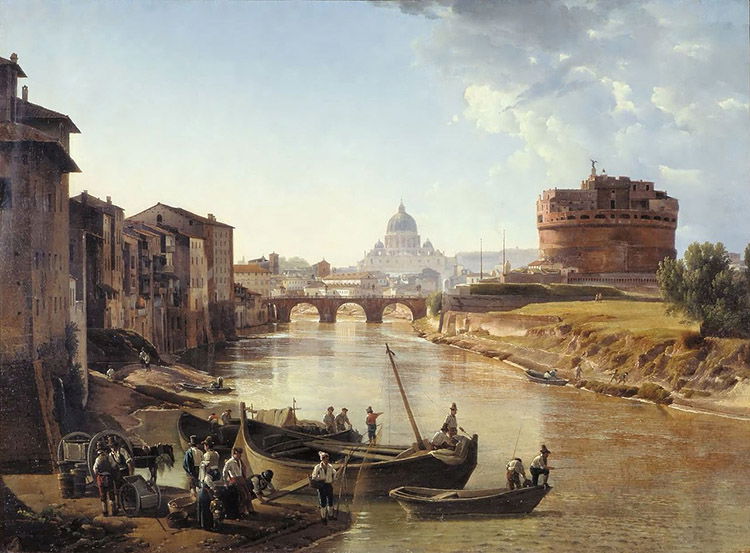
Leo took refuge in the Castel Sant’Angelo, either from genuine fear or to sustain the illusion of a plot. A guard of 100 soldiers was placed on the gates. He issued a threatening motu proprio that pointed to the involvement of other cardinals in the ‘diabolical’, ‘clandestine’ and ‘secret’ scheming. Three judges were appointed from among the College of Cardinals to try their colleagues’ case.
The plot thickens
Sauli’s brothers were confident they could raise the funds needed to guarantee his release. Cardinal Riario was not so sure. This was not politics as usual and, on 29 May, Riario was arrested, too. Those under interrogation had named him. At first, Riario was allowed to remain in the Apostolic Palace, in a room normally used by the pope’s personal chamberlain and treasurer. Then, on 2 June, Scipione Petrucci, who appears not to have cooperated with the judges up to this point (he had been imprisoned since 15 April) suddenly declared he could remember a series of meetings with Battista da Vercelli and Marcantonio Nini. His testimony neatly supported Nini’s earlier statements.
Riario was moved from the comfortable rooms of the papal palace into the cells of the Castel Sant’Angelo. He had to be carried on a litter: ‘I don’t think he’ll live two days,’ observed an eyewitness, as a result of the likely impact of torture. Meanwhile, the rumours circulating in Rome became ever more extravagant: they told of plots to kill the pope while he was hunting; plots to attack him during a procession for the feast of Corpus Christi. In Florence, Leo’s loyal servant Goro Gheri insisted that not only should the cardinals be punished, but their families, too, as an example to others.
On 5 June, perhaps after torture, Riario confessed. He claimed that he had tried to dissuade Petrucci; others, however, claimed (plausibly) that he was the plotters’ candidate for pope. Battista da Vercelli confessed, too. On 8 June Leo announced in Consistory that two other cardinals were complicit in the plot: Francesco Soderini and Adriano Castellesi. Their crime was to have heard Petrucci speak of his desire for Leo’s death and to have said nothing. They made their confessions and were fined 12,500 ducats each.
Financial motives
The money is important, because it gave Leo a motive to frame the alleged plotters. There is ample evidence that Leo was struggling financially at this time. Back in September 1513, on the occasion of the spectacular citizenship ceremony for Giuliano and Lorenzo de’ Medici, he had given away a series of lucrative church offices. On 9 June 1517, a decree was issued announcing they were up for sale again, presumably to the highest bidder. Moreover, Leo had the prospect of selling offices and redistributing benefices confiscated from the plotters to friends and allies.
The legal process rolled on. On 16 June Pochintesta was hanged at Tor di Nona, the papal prison on the banks of the Tiber. On 22 June the cardinals found Riario, Sauli and Petrucci guilty, although not without objections. Cardinal della Rovere, a relative of Riario, asked: ‘The devil take it, do you think that these are true confessions?’ The cardinals were deprived of their benefices and – worse – were handed over to secular justice, which opened the way to the death penalty.
That fate befell the lower-ranking conspirators on 27 June. Nini and Vercelli were hung, drawn and quartered. Their bodies were displayed on the bridge outside the Castel Sant’Angelo.
Leo’s next move was astonishing. On 1 July he appointed 31 new cardinals, more than doubling the size of the college. Since the re-establishment of a single papacy in Rome 70 years before, the record for a single creation had been 12. Four of the new men were Florentines; others were Medici allies and in-laws; two were Sienese, including Raffaele Petrucci, from a rival branch of Cardinal Alfonso’s family. The influence of the old guard was permanently diluted; the new men owed Leo for their appointments; the pope had the compliant college he wanted.
Cardinal Petrucci’s execution three days later raised alarm among the remaining conspirators. Sauli’s family went to France to ask the crown to intervene on his behalf. The government of his home city of Genoa intervened, too. Castellesi fled Rome and was deprived of his benefices on 5 July. He was later stripped of the cardinalate, with encouragement from Cardinal Wolsey. Soderini tricked Leo’s guards into following a decoy entourage, while he made his way discreetly out of Rome.
Perhaps thanks to Genoese lobbying, Sauli was moved to a more comfortable cell. Riario’s friends began to make arrangements to guarantee payment of his fine, which was set at a staggering 150,000 ducats. Forty years on from the Pazzi Conspiracy, this was cold revenge. Agostino Chigi, the richest man in Rome, guaranteed a third of the sum and on 24 July Riario was released and exiled to Naples. A week later, on 31 July, Sauli was released, too; he was fined 25,000 ducats and was confined to his house in Monterotondo. Unlike Riario, he lost most of his benefices. He died the following year, his illness almost certainly aggravated by his ordeal in prison.
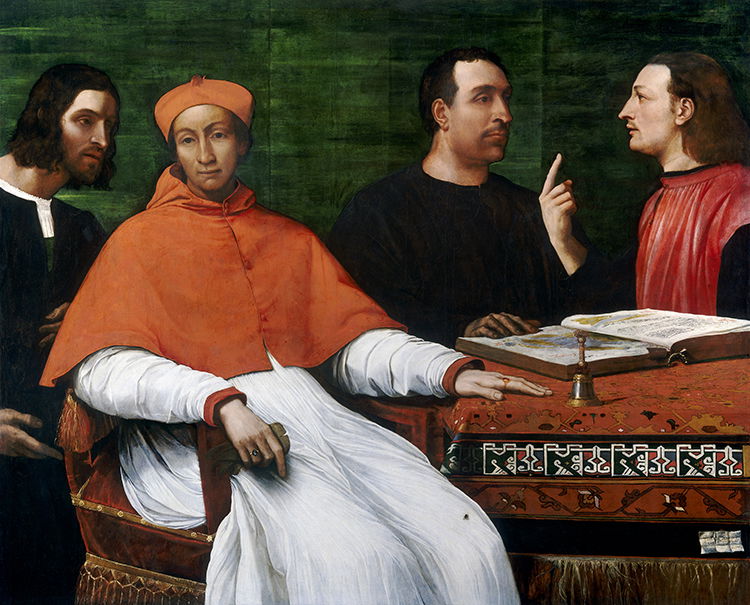
The Venetian diarist Marin Sanuto reckoned Leo had made half a million ducats. That was ten times the annual income of the richest cardinal and 250 times the income of the poorest.
Careless talk and consequences
We will never be certain about the extent to which the cardinals discussed, desired or even schemed to achieve the pope’s death. There is little doubt that opponents of the Medici would have liked to overthrow them and there was good reason for Leo to be anxious about plots. Petrucci’s anger over Siena was real and understandable: he had a motive. The others had at least some reason to support him and there is evidence that Sauli’s allies, at least, did not contest his guilt after the event.
On the other hand, Leo had both financial and political motives to act against his rivals. It was not an impartial investigation: one of the appointed judges had an axe to grind against Petrucci; the interrogators and their relatives were given a lucrative share of the disgraced cardinals’ benefices and key city offices.
So far as evidence goes, most of the supposedly compromising letters do not survive. One, dated 12 August 1516, does. It was written a day after the letter that supposedly named Vercelli. The interrogators annotated it with comments that exaggerated the actual content. It is unlikely that a competent political player in this period would have put the name of a potential assassin in writing. Sensitive messages were almost always conveyed orally. Moreover, there was a simple explanation for the doctor Vercelli’s desire to remain at court with the pope: he had genuine hopes of entering papal service and thus taking a step up the career ladder. One would have to be particularly suspicious to conclude that he was doing so in order to poison Leo.
For me, the most likely explanation of the whole affair is suggested by the contemporary physician and scholar Paolo Giovio. In his account, Petrucci really did threaten to kill the pope; the other cardinals laughed and made fun of him. Said one way, ‘I’m going to kill the pope’ can be an empty boast. Said another, it can be a genuine threat. In an atmosphere of high tension – as the Medici circle certainly was after Giuliano’s death and Leo’s illness – such comments could be interpreted as conspiracy to murder. Students of English history might be reminded of the way careless talk about a ruler’s death provided vital evidence against Anne Boleyn. In her case, she admitted to a conversation with a courtier, Henry Norris, about what might happen should Henry VIII die. It is not hard to imagine the Cardinals’ Conspiracy emanating from similarly loose talk.
1517 is a notable year in religious history for other reasons. Martin Luther published his 95 Theses. Luther had come to Rome seven years before and was horrified by its iniquities. For the rest of his time as pope, Leo’s theologians crossed swords with Luther. Within a few years Leo had excommunicated his adversary. Yet the pope’s political priorities lay elsewhere, in securing his family as rulers of Florence. On his death in 1521 he handed on the baton to his cousin, Cardinal Giulio de’ Medici. He had to wait 18 months until he got his turn as pope, elected in the conclave of 1523. As Clement VII he saw Henry VIII break with the authority of Rome. He also established the Medici as the hereditary dukes of Florence.
It is impossible to say what might have been had Leo’s predecessor Julius II lived longer, or had a pope with fewer family considerations in the Italian wars been elected in Leo’s place. In 1911, the authors of the Catholic Encyclopaedia concluded that: ‘The only possible verdict on the pontificate of Leo X is that it was unfortunate for the Church.’ It was more than unfortunate for the five cardinals accused of plotting murder at the Vatican.
Catherine Fletcher is Associate Professor in History and Heritage at Swansea University and author of The Black Prince of Florence (Vintage, 2016). This piece was originally published in the October 2017 issue of History Today.
Further reading
Marcello Simonetta, Volpi e Leoni: I Misteri dei Medici (2017)
Helen Hyde, Cardinal Bendinello Sauli and Church Patronage in Sixteenth-Century Italy (2009)
Kate Lowe, Church and Politics in Renaissance Italy: The life and career of cardinal Francesco Soderini, 1453-1524 (1993)



